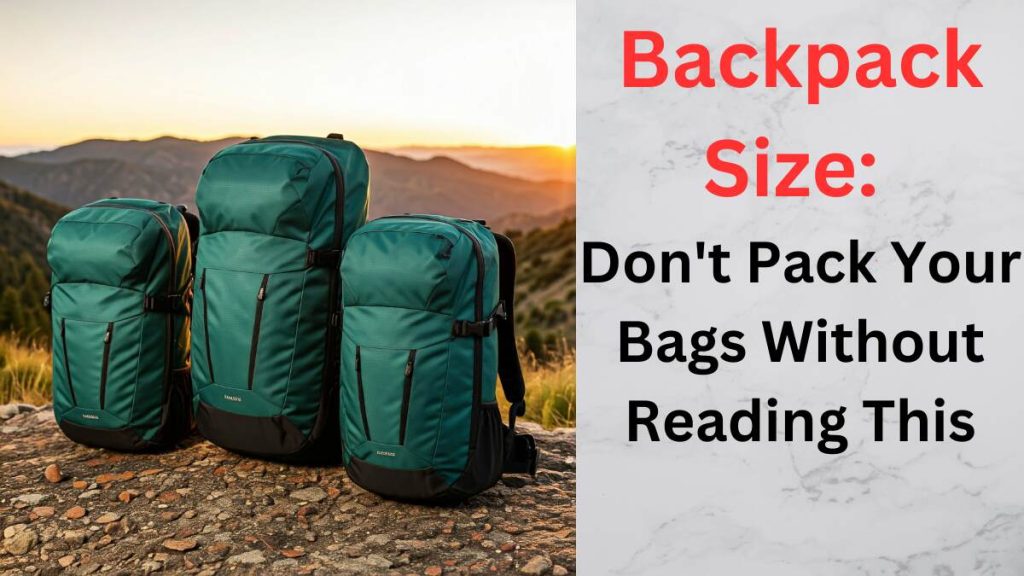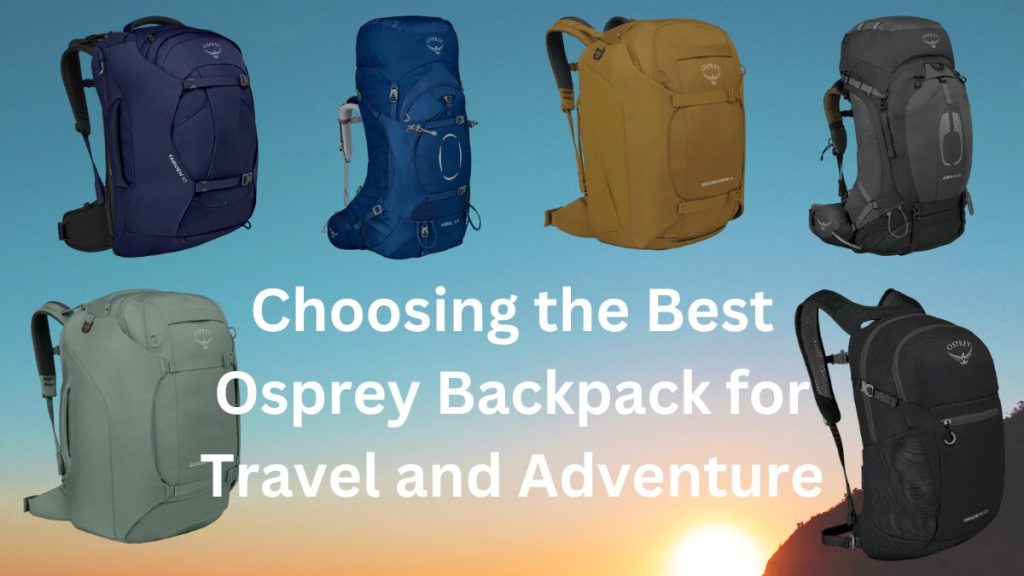Choosing the right hiking backpack is crucial for a comfortable and enjoyable outdoor experience. The question, “what size hiking backpack do I need?” is a common one, and the answer depends on various factors. The primary consideration is the type and duration of your hike. For a day hike, a smaller backpack in the range of 20-30 liters is sufficient to carry essentials like water, snacks, a first-aid kit, and extra layers. However, for overnight or multi-day hikes, you’ll need a larger backpack, typically ranging from 40 to 70 liters, to accommodate camping gear, food, and additional clothing.
Another important factor is your body size and the weight you’ll be carrying. It’s essential to choose a backpack that fits you well and distributes the weight evenly across your hips and shoulders.
A poorly fitting backpack can lead to discomfort and even injury. Additionally, consider the features you need, such as hydration compatibility, multiple compartments, and a rain cover.
Ultimately, the best way to determine the right size hiking backpack is to try on different sizes and models to find the one that fits you best and meets your specific needs. By carefully considering these factors, you can select a backpack that will enhance your hiking adventures and ensure a comfortable and enjoyable experience.
Post Contents
what size hiking backpack do i need
Below is a quick answer to your question “what size hiking backpack do I need”.
| Length of Hike | Capacity (Volume) | Pack Suggested Use |
|---|---|---|
| A few hours | 6-10 Liters | Short hikes or walks, Kid’s bag, Sports |
| 1 day | 10-30 Liters | Commuting, Day hikes or walks |
| 1-3 nights | 30-50 Liters | Weekends Trips, Camping, Multi Day Hikes and treks |
| 3-5 nights | 50-80 Liters | Traveling, Backpacking trips, Multi day treks |
| 5+ nights | 70 liters or larger | Extended treks, Off the path hikes, Winter treks |
Why Backpack Size Matters for Hiking
A well-fitted backpack is a hiker’s best friend. The right size ensures comfort, efficiency, and safety on the trail.
A backpack that’s too small can lead to discomfort as you try to cram in too much gear. This can also affect your posture and balance.
A backpack that’s too large can be cumbersome and heavy, especially when it’s not fully packed. This can lead to unnecessary strain on your back and shoulders.
The ideal backpack size depends on the duration and intensity of your hike. For shorter day hikes, a smaller pack is sufficient. For multi-day backpacking trips, a larger pack is necessary to carry camping gear and supplies.
By choosing the right size backpack, you can make your hiking adventures more enjoyable and less stressful.
Types of Hiking Backpacks by Duration

1. Daypacks (10-30 Liters)
For quick day hikes or short trips, a daypack is the perfect choice. These compact backpacks, typically ranging from 10 to 30 liters, are designed to carry essential items like water bottles, snacks, a light jacket, and a first-aid kit. They’re ideal for various outdoor activities, from hiking and biking to casual outings.

Ideal For:
- Day hikes
- Bike rides
- Urban adventures
- Light gear loads
- Short-distance adventures
2. Weekend Backpacks (30-50 Liters)
When planning an overnight or weekend camping trip, a weekend backpack is the ideal companion. These mid-sized packs, ranging from 30 to 50 liters, offer sufficient space for overnight gear, including a sleeping bag, a small tent, a stove, and extra clothing. They’re versatile enough for various outdoor activities, from camping to hiking.

Ideal For:
- Overnight camping trips
- 1-3 night trips
- Weekend hikes
- Backpacking trips
3. Multi-Day Backpacks (50-70 Liters)
For those embarking on multi-day adventures, a multi-day backpack is essential. These larger packs, ranging from 50 to 70 liters, provide ample space for extended trips. They can accommodate additional gear, food, and water, making them suitable for backpacking trips, trekking, and mountaineering.

Ideal For:
- Multi-day hikes
- 3-5 night trips
- Backpacking trips
- Trekking expeditions
4. Expedition Backpacks (70+ Liters)
Expedition backpacks are designed for serious outdoor enthusiasts who plan to spend extended periods in remote locations. These large packs, typically 70 liters or more, are built to carry heavy loads, including camping gear, food, and survival equipment. They’re ideal for long-distance hikes, mountaineering expeditions, and other demanding outdoor activities.

Ideal For:
- 5+ night trips
- High-altitude or remote hiking
- Carrying heavy gear load
- Mountaineering expeditions
- Remote wilderness trips
Factors to Consider When Choosing Backpack Size
1. Trip Duration and Load Requirements
The duration of your hike is a primary factor in determining the appropriate backpack size. For day hikes, a smaller backpack, typically between 10-30 liters, is sufficient to carry essentials like water, snacks, a first-aid kit, and extra layers.
However, for overnight or multi-day hikes, you’ll need a larger backpack, ranging from 30-70 liters, to accommodate camping gear, food, and additional clothing. The specific size will depend on the number of nights you’ll be out, the weight of your gear, and the level of comfort you prefer.

2. Season and Weather Conditions
The season and weather conditions can significantly impact the size of backpack you need. In colder climates, you’ll need to pack additional gear like warm layers, a sleeping bag, and extra food, which will require a larger backpack.
Conversely, in warmer weather, you may need less gear, allowing for a smaller backpack. It’s important to consider the specific conditions of your hike, such as rain, snow, or extreme heat, and pack accordingly.
3. Backpack Features and Comfort
Beyond size, the features and comfort of your backpack are crucial for a pleasant hiking experience. Look for backpacks with adjustable straps, padded hip belts, and a well-ventilated back panel to distribute weight evenly and reduce discomfort.
Larger backpacks often come with additional features like hydration compartments, multiple pockets, and rain covers. Consider your specific needs and preferences when choosing a backpack with the right features.
How to Measure for the Perfect Fit
A backpack’s fit is just as important as its size. A well-fitting backpack can significantly improve your comfort and experience on the trail. To ensure the best fit, it’s essential to measure your torso length and adjust the backpack’s straps correctly.
Measuring Your Torso Length
To determine the correct torso length for your backpack, follow these steps:
- Find Your Starting Point: Locate the base of your neck, where it meets your shoulders.
- Identify Your Ending Point: Find the top of your hip bones.
- Measure the Distance: Using a soft measuring tape, measure the distance between these two points.
Checking Hip Belt Fit
The hip belt is a crucial component of a backpack, as it transfers the majority of the weight from your shoulders to your hips. A well-fitted hip belt can significantly reduce strain on your back and shoulders.
To ensure a proper fit:
- Snug Fit: The hip belt should fit snugly around your hips, without being too tight or too loose.
- Weight Distribution: The weight of the backpack should be primarily supported by your hips, not your shoulders.
- Adjustability: Most backpacks have adjustable hip belts to accommodate different body sizes.
Adjusting Shoulder Straps
The shoulder straps are another important factor in a backpack’s fit. They should be comfortably padded and positioned to relieve weight from your back and shoulders.
To adjust your shoulder straps:
- Proper Position: The shoulder straps should sit comfortably on your shoulders, without digging into your neck or armpits.
- Load Transfer: The straps should transfer the weight of the pack to your hips, minimizing strain on your shoulders.
- Adjustability: Most backpacks have adjustable shoulder straps to accommodate different torso lengths and body types.
By following these tips, you can ensure that your backpack fits you perfectly, making your hiking adventures more comfortable and enjoyable.
Tips for Packing Efficiently
- Prioritize Essentials: Pack only what you need, keeping in mind the weight and purpose of each item.
- Organize by Weight: Place heavier items closer to your back to help with balance.
- Use Packing Cubes: Packing cubes and compression bags help keep items organized and minimize space.
Choosing the Right Backpack for Your Next Adventure
In conclusion, selecting the right size hiking backpack is crucial for a comfortable and enjoyable outdoor experience. By considering factors such as trip duration, load requirements, weather conditions, and personal preferences, you can make an informed decision. Remember to prioritize a backpack that fits well and distributes weight evenly.
To ensure a perfect fit, measure your torso length and adjust the straps accordingly. A well-fitted backpack can significantly enhance your comfort and reduce the risk of injury.
Whether you’re embarking on a day hike or a multi-day trek, having the right backpack can make all the difference. By following these guidelines, you can confidently choose a backpack that will meet your needs and elevate your outdoor adventures.
We hope this guide has been helpful!
Please like, share, and comment below with your thoughts and experiences. We’d love to hear from you!




